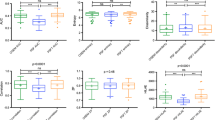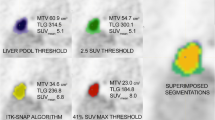Abstract
Objectives
Measuring tumour heterogeneity by textural analysis in 18F-fluorodeoxyglucose positron emission tomography (18F-FDG PET) provides predictive and prognostic information but technical aspects of image processing can influence parameter measurements. We therefore tested effects of image smoothing, segmentation and quantisation on the precision of heterogeneity measurements.
Methods
Sixty-four 18F-FDG PET/CT images of oesophageal cancer were processed using different Gaussian smoothing levels (2.0, 2.5, 3.0, 3.5, 4.0 mm), maximum standardised uptake value (SUVmax) segmentation thresholds (45 %, 50 %, 55 %, 60 %) and quantisation (8, 16, 32, 64, 128 bin widths). Heterogeneity parameters included grey-level co-occurrence matrix (GLCM), grey-level run length matrix (GLRL), neighbourhood grey-tone difference matrix (NGTDM), grey-level size zone matrix (GLSZM) and fractal analysis methods. The concordance correlation coefficient (CCC) for the three processing variables was calculated for each heterogeneity parameter.
Results
Most parameters showed poor agreement between different bin widths (CCC median 0.08, range 0.004–0.99). Segmentation and smoothing showed smaller effects on precision (segmentation: CCC median 0.82, range 0.33–0.97; smoothing: CCC median 0.99, range 0.58–0.99).
Conclusions
Smoothing and segmentation have only a small effect on the precision of heterogeneity measurements in 18F-FDG PET data. However, quantisation often has larger effects, highlighting a need for further evaluation and standardisation of parameters for multicentre studies.
Key points
• Heterogeneity measurement precision in 18 F-FDG PET is influenced by image processing methods.
• Quantisation shows large effects on precision of heterogeneity parameters in 18 F-FDG PET/CT.
• Smoothing and segmentation show comparatively smaller effects on precision of heterogeneity parameters.



Similar content being viewed by others
References
Gambhir SS, Czernin J, Schwimmer J, Silverman DH, Coleman RE, Phelps ME (2001) A tabulated summary of the FDG PET literature. J Nucl Med 42:1S–93S
Krause BJ, Schwarzenböck S, Souvatzoglou M (2013) FDG PET and PET/CT. Recent Results Cancer Res 187:351–369
Tixier F, Le Rest CC, Hatt M et al (2011) Intratumor heterogeneity characterized by textural features on baseline 18 F-FDG PET images predicts response to concomitant radiochemotherapy in esophageal cancer. J Nucl Med 52:369–378
Dong X, Xing L, Wu P et al (2013) Three-dimensional positron emission tomography image texture analysis of esophageal squamous cell carcinoma: relationship between tumor 18 F-fluorodeoxyglucose uptake heterogeneity, maximum standardized uptake value, and tumor stage. Nucl Med Commun 34:40–46
Cook GJ, Yip C, Siddique M, Goh V et al (2013) Are pretreatment 18 F-FDG PET tumor textural features in non-small cell lung cancer associated with response and survival after chemoradiotherapy? J Nucl Med 54:19–26
Chicklore S, Goh V, Siddique M, Roy A, Marsden PK, Cook GJ (2013) Quantifying tumour heterogeneity in 18 F-FDG PET/CT imaging by texture analysis. Eur J Nucl Med Mol Imaging 40:133–140
Davnall F, Yip CS, Ljungqvist G et al (2012) Assessment of tumor heterogeneity: an emerging imaging tool for clinical practice? Insights Imaging 3:573–589
Castellano G, Bonilha L, Li LM, Cendes F (2004) Texture analysis of medical images. Clin Radiol 59:1061–1069
Haralick RM, Shanmugam K, Dinstein I (1973) Textural features for image classification. IEEE Trans Syst Man Cybern 3:610–621
Amadasun M, King R (1989) Textural features corresponding to textural properties. IEEE Trans Syst Man Cybern 19:1264–1274
Galloway MM (1975) Texture analysis using gray level run lengths. Comput Graph Image Process 4:172–179
Chu A, Sehgal CM, Greenleaf JF (1990) Use of gray value distribution of run lengths for texture analysis. Pattern Recognit Lett 11:415–420
Dasarathy BR, Holder EB (1991) Image characterizations based on joint gray-level run-length distributions. Pattern Recognit Lett 12:497–502
Thibault G, Angulo J, Meyer F (2014) Advanced statistical matrices for texture characterization: application to cell classification. IEEE Trans Biomed Eng 61:630–637
Lopes R, Betrouni N (2009) Fractal and multifractal analysis: a review. Med Image Anal 13:634–649
Goh V, Sanghera B, Wellsted DM, Sundin J, Halligan S (2009) Assessment of the spatial pattern of colorectal tumour perfusion estimated at perfusion CT using two-dimensional fractal analysis. Eur Radiol 19:1358–1365
Tamal M (2012) Threshold based segmentation in positron emission tomography for radiotherapy planning and treatment assessment. Curr Mol Imaging 1:63–68
Hatt M, Cheze le Rest C, Turzo A, Roux C, Visvikis D (2009) A fuzzy locally adaptive Bayesian segmentation approach for volume determination in PET. IEEE Trans Med Imaging 28:881–893
Soh LK, Tsatsoulis C (1999) Texture analysis of SAR sea ice imagery using gray level co-occurrence matrices. IEEE Trans Geosci Remote Sens 37:780–795
Schleyer PJ, Baker S, Barrington SF et al (2008) Establishment of acquisition and reconstruction parameters for a GE Discovery VCT PET-CT scanner. Eur J Nucl Med Mol Imaging 35:S340–S341
Lin LIK (1989) A concordance correlation coefficient to evaluate reproducibility. Biometrics 45:255–268
Strother SC, Lange N, Anderson JR et al (1997) Activation pattern reproducibility: measuring the effects of group size and data analysis models. Hum Brain Map 5:312–316
Lange N, Strother SC, Anderson JR et al (1999) Plurality and resemblance in fMRI data analysis. NeuroImage 10:282–303
Vrenken H, Vos EK, van der Flier WM et al (2013) Validation of the automated method VIENA: an accurate, precise, and robust measure of ventricular enlargement. Hum Brain Map 35:1101–1110
McBride GB (2005) A proposal for strength-of-agreement criteria for Lin's concordance correlation coefficient. http://www.niwa.co.nz/node/104318/concordance. Accessed 10 Jan 2015
Tixier F, Hatt M, Le Rest CC, Le Pogam A, Corcos L, Visvikis D (2012) Reproducibility of tumor uptake heterogeneity characterization through textural feature analysis in 18 F-FDG PET. J Nucl Med 53:693–700
Galavis PE, Hollensen C, Jallow N, Paliwal B, Jeraj R (2010) Variability of textural features in FDG PET images due to different acquisition modes and reconstruction parameters. Acta Oncologica 49:1012–1016
Nock R, Nielsen F (2006) On weighting clustering. IEEE Trans Pattern Anal Mac Intell 28:1–13
Orlhac F, Soussan M, Maisonobe JA, Garcia CA, Vanderlinden B, Buvat I (2014) Tumor texture analysis in 18 F-FDG PET: relationships between texture parameters, histogram indices, standardized uptake values, metabolic volumes, and total lesion glycolysis. J Nucl Med 55:414–422
Nestle U, Kremp S, Schaefer-Schuler A et al (2005) Comparison of different methods for delineation of 18 F-FDG PET-positive tissue for target volume definition in radiotherapy of patients with non-small cell lung cancer. J Nucl Med 46:1342–1348
Hatt M, Tixier F, Cheze Le Rest C, Pradier O, Visvikis D (2013) Robustness of intratumour 18F-FDG PET uptake heterogeneity quantification for therapy response prediction in oesophageal carcinoma. Eur J Nucl Med Mol Imaging 40:1662–1671
Brooks FJ, Grigsby PW (2014) The effect of small tumor volumes on studies of intratumoral heterogeneity of tracer uptake. J Nucl Med 55:37–42
Acknowledgements
The authors acknowledge support from the National Institute for Health Research Biomedical Research Centre of Guys & St Thomas’ NHS Trust in partnership and King’s College London and University College London Comprehensive Cancer Imaging Centre funded by Cancer Research UK and Engineering and Physical Sciences Research Council in association with the Medical Research Council and Department of Health (England). The scientific guarantor of this publication is Gary Cook. The authors of this manuscript declare no relationships with any companies whose products or services may be related to the subject matter of the article.
No complex statistical methods were necessary for this paper. Institutional review board approval was not required because of the retrospective nature of the analysis of anonymised data. Written informed consent was waived by the institutional review board. Methodology: retrospective, observational, performed at one institution.
Author information
Authors and Affiliations
Corresponding author
Rights and permissions
About this article
Cite this article
Doumou, G., Siddique, M., Tsoumpas, C. et al. The precision of textural analysis in 18F-FDG-PET scans of oesophageal cancer. Eur Radiol 25, 2805–2812 (2015). https://doi.org/10.1007/s00330-015-3681-8
Received:
Revised:
Accepted:
Published:
Issue Date:
DOI: https://doi.org/10.1007/s00330-015-3681-8




